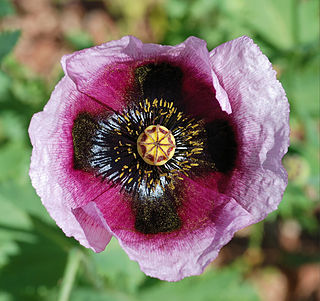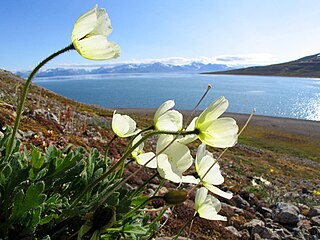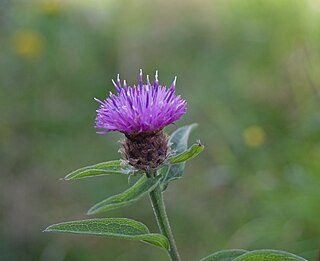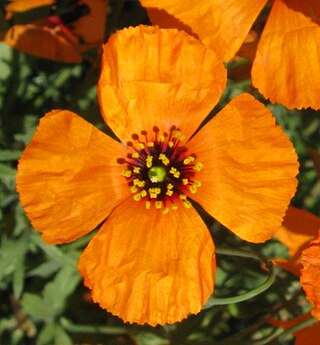
Eschscholzia californica, the California poppy, golden poppy, California sunlight or cup of gold, is a species of flowering plant in the family Papaveraceae, native to the United States and Mexico. It is cultivated as an ornamental plant flowering in summer, with showy cup-shaped flowers in brilliant shades of red, orange and yellow. It is also used as food or a garnish. It became the official state flower of California in 1903.

Papaver rhoeas, with common names including common poppy, corn poppy, corn rose, field poppy, Flanders poppy, and red poppy, is an annual herbaceous species of flowering plant in the poppy family Papaveraceae. It is native to north Africa and temperate Eurasia and is introduced into temperate areas on all other continents except Antarctica.

Papaver is a genus of 70–100 species of frost-tolerant annuals, biennials, and perennials native to temperate and cold regions of Eurasia, Africa and North America. It is the type genus of the poppy family, Papaveraceae.

The Papaveraceae are an economically important family of about 42 genera and approximately 775 known species of flowering plants in the order Ranunculales, informally known as the poppy family. The family is cosmopolitan, occurring in temperate and subtropical climates like Eastern Asia as well as California in North America. It is almost unknown in the tropics. Most are herbaceous plants, but a few are shrubs and small trees. The family currently includes two groups that have been considered to be separate families: Fumariaceae and Pteridophyllaceae. Papaver is the classical name for poppy in Latin.

Primula vulgaris, the common primrose, is a species of flowering plant in the family Primulaceae, native to Eurasia. The common name is primrose, or occasionally common primrose or English primrose to distinguish it from other Primula species referred to as primroses.

Papaver dahlianum, commonly called the Svalbard poppy, is a poppy species common on Svalbard, north-eastern Greenland and a small area of northern Norway. It is the symbolic flower of Svalbard. Some sources regard this species as part of Papaver radicatum.

Papaver nudicaule, the Iceland poppy, is a boreal flowering plant. Native to subpolar regions of Asia and North America, and the mountains of Central Asia as well as temperate China, Iceland poppies are hardy but short-lived perennials, often grown as biennials. They yield large, papery, bowl-shaped, lightly fragrant flowers supported by hairy, 1 foot (30 cm) curved stems among feathery blue-green foliage 1–6 inches long. They were first described by botanists in 1759. The wild species blooms in white or yellow, and is hardy from USDA Zones 3a-10b.

Dicentra formosa is a flowering plant with fern-like leaves and an inflorescence of drooping pink, purple, yellow or cream flowers native to the Pacific Coast of North America.

Antirrhinum majus, the common snapdragon, is a species of flowering plant belonging to the genus Antirrhinum. The plant was placed in the family Plantaginaceae following a revision of its prior classical family, Scrophulariaceae.

Platystemon is a monotypic genus of flowering plants in the poppy family containing the single species Platystemon californicus, which is known by the common name creamcups. It is native to Oregon, California, Arizona, Utah and Baja California, and is found in open grasslands and sandy soils below 6,000 feet (1,800 m) elevation.

Roemeria argemone is a species of flowering plant in the poppy family Papaveraceae. Its common names include long pricklyhead poppy, prickly poppy and pale poppy. Its native range includes parts of Eurasia and North Africa, but it can be found growing wild in parts of North America, where it is an introduced species. It is cultivated as an ornamental plant.

Diplotaxis muralis, the annual wall-rocket, is a species of flowering plant in the family Brassicaceae. This plant is native to Europe, Asia, and Africa, but it is found throughout the temperate world, where it has naturalized. This is an erect mustard-like plant rarely reaching half a meter in height. It has lobed leaves and its stems are topped with dense inflorescences of yellow, or occasionally light purple, flowers with small oval petals and large anthers. The fruit is a podlike silique two to four centimeters long.

Papaver alpinum, synonym Oreomecon alpina, the Alpine poppy or dwarf poppy, is a poppy found in the Alps. The circumscription of the species varies considerably. In some treatments, the species is one of a group of related species, and includes several subspecies, four of which are found in Austria. In other treatments, it includes species that have been treated as separate, and has at most one subspecies.

Centaurea nigra is a species of flowering plant in the family Asteraceae known by the common names lesser knapweed, common knapweed and black knapweed. A local vernacular name is hardheads.

Papaver umbonatum is a species of flowering plant in the family Papaveraceae. It is referred to by the common name Semitic poppy. It is often confused and misidentified as Papaver rhoeas even though it is classified as the rest of the subspecies, since they are very similar in form and appearance. Its native range includes the rocky plains of Lebanon and Palestine.

Sedum spathulifolium is a species of flowering plant in the family Crassulaceae known by the common names broadleaf stonecrop, yellow stonecrop, and spoon-leaved stonecrop. An evergreen perennial, it is native to western North America from British Columbia to southern California, where it can be found often in shade in many types of rocky habitat in coastal and inland hills and mountains.

Galearis rotundifolia is a species of flowering plants in the orchid family, Orchidaceae. It is commonly called roundleaf orchis and small round-leaved orchid. It is a succulent perennial herb native to North America, where it occurs throughout Canada, part of the northern United States, and Greenland.

Papaver setigerum, common name poppy of Troy or dwarf breadseed poppy, is a herbaceous annual plant of the family Papaveraceae.

Papaver dubium is a species of poppy known by the common names long-headed poppy and blindeyes. It is an annual species which prefers sandy soils without lime. It is native to Europe, North Africa and south-western Asia and widespread as an introduction in America and elsewhere.

Papaver heterophyllum, previously known as Stylomecon heterophylla, and better known as the wind poppy, is a winter annual herbaceous plant. It is endemic to the western California Floristic Province and known to grow in the area starting from the San Francisco Bay Area of Central Western California southwards to northwestern Baja California, Mexico. Its main habitat is often described as mesic and shady, with loamy soils such as soft sandy loam, clay loam, and leaf mold loam.



















